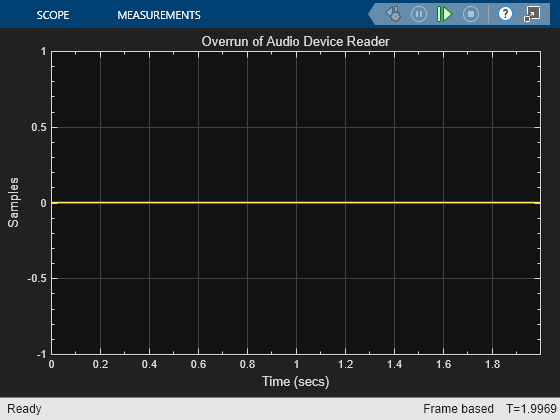Audio Device Reader
Record from sound card
Libraries:
Audio Toolbox /
Sources
Description
The Audio Device Reader block reads audio samples using your computer's audio device. The Audio Device Reader block specifies the driver, the device and its attributes, and the data type and size output from your Audio Device Reader block.

Examples
Read from Microphone and Write to Speaker
Examine the Audio Device Reader block in a Simulink® model, modify parameters, and explore overrun.
Ports
Output
The output of the Audio Device Reader block is determined by the block’s parameters. If the block output is a matrix, the columns correspond to independent channels.
Data Types: single | double | int16 | int32 | uint8
This port outputs the number of samples overrun while acquiring a frame of data (one output matrix).
Dependencies
To enable this port, select the Output number of samples overrun parameter.
Data Types: uint32
Parameters
Main Tab
ASIO drivers do not come pre-installed on Windows machines. To use the
ASIOdriver option, install an ASIO driver outside of MATLAB®.Note
If Driver is set to
ASIO, open the ASIO UI outside of MATLAB to set the sound card buffer size to the value specified by the Samples per frame parameter. See the documentation of your ASIO driver for more information.WASAPI drivers are supported for exclusive-mode only.
ASIO and WASAPI drivers do not provide sample rate conversion. For ASIO and WASAPI drivers, set Sample rate (Hz) to a sample rate supported by your audio device.
This parameter applies only on Windows machines. Linux machines always use the ALSA driver. Mac machines always use the CoreAudio driver.
The device list is populated with devices available on your computer.
This button opens a dialog box that lists your selected audio driver, the full name of your audio device, and the maximum input channels for your configuration. For example:

The possible range of Sample rate (Hz) depends on your audio hardware.
The number of input channels is also the number of channels (matrix columns) output by the Audio Device Reader block.
Dependencies
To specify which input channels your audio device acquires, on the Advanced tab, select the Use default channel mapping parameter.
Samples per frame is also the device buffer size, and the frame size (number of matrix rows) output by the Audio Device Reader block.
Advanced Tab
Data type used by device to acquire audio data, specified as a character vector or string.
When you select this parameter, the block uses the default mapping between the sound card’s input channels and the matrix columns output by this block. When you clear this parameter, you specify the mapping in Device input channels.
Nondefault map of device channels and matrix output by the Audio Device Reader block, specified as a scalar or vector. For example:
If Device input
channels is specified as
1:3, then:
Channel 1 maps to the first column of the output matrix.
Channel 2 maps to the second column of the output matrix.
Channel 3 maps to the third column of the output matrix.
If Device input
channels is specified as
[3,1,2], then:
Channel 3 maps to the first column of the output matrix.
Channel 1 maps to the second column of the output matrix.
Channel 2 maps to the third column of the output matrix.
Dependencies
To specify a nondefault mapping, clear the Use default channel mapping parameter.
When you select this parameter, an additional output port, O, is added to the block. The O port outputs the number of samples overrun while acquiring a frame of data (one output matrix).
Data type of the output.
Note
If this parameter is specified as
double or
single, the block outputs data
in the range [–1, 1]. For other data types, the
range is [min, max] of the specified data
type.
Block Characteristics
Extended Capabilities
The executable generated from this block relies on prebuilt
dynamic library files (.dll files) included with MATLAB. Use the packNGo function
to package the code generated from this object and all the
relevant files in a compressed zip file. Using this zip
file, you can relocate, unpack, and rebuild your project in
another development environment where MATLAB is not installed. For more details, see Run Audio I/O Features Outside MATLAB and Simulink.
Version History
Introduced in R2016a
MATLAB Command
You clicked a link that corresponds to this MATLAB command:
Run the command by entering it in the MATLAB Command Window. Web browsers do not support MATLAB commands.
选择网站
选择网站以获取翻译的可用内容,以及查看当地活动和优惠。根据您的位置,我们建议您选择:。
您也可以从以下列表中选择网站:
如何获得最佳网站性能
选择中国网站(中文或英文)以获得最佳网站性能。其他 MathWorks 国家/地区网站并未针对您所在位置的访问进行优化。
美洲
- América Latina (Español)
- Canada (English)
- United States (English)
欧洲
- Belgium (English)
- Denmark (English)
- Deutschland (Deutsch)
- España (Español)
- Finland (English)
- France (Français)
- Ireland (English)
- Italia (Italiano)
- Luxembourg (English)
- Netherlands (English)
- Norway (English)
- Österreich (Deutsch)
- Portugal (English)
- Sweden (English)
- Switzerland
- United Kingdom (English)
